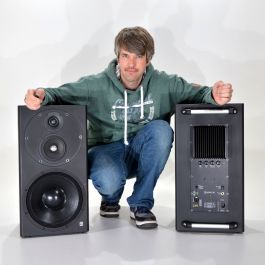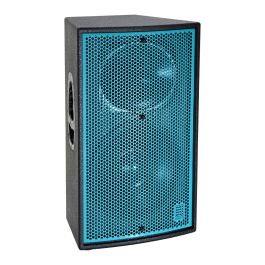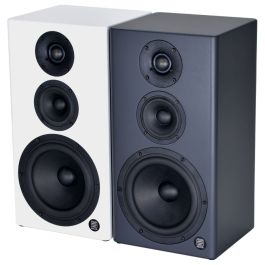I stumbled upon this monitor and it seemed like a very interesting product to me:
https://translate.google.com/transl...ktivlautsprecher/studiomonitore/mirra-14.html
- Good quality components
- Wavecor TW030WA09/10, WF120BD05/06 and WF223BD01/02
- DSP room correction available
- Decent price if it performs as promised: €2490.- per pair (€1990.- for early birds)
View attachment 110394
View attachment 110395
Their own measurements look good, and I'm a big fan of the "science-based" crowd development approach to speaker development "ABACUS expects feedback from a professional application environment, if necessary with specific suggestions for improvement and ideally measurements" (this is specifically aimed at people that participate in the crowd development deal).
View attachment 110397
Hey I reckon this crew(Abacus) are good for it! I stumbled across their baby monitor- the C-Box 3 about 4yrs ago and was well curious.
So went on a online hunt to see what I could find on them, which ended up being very little! What little I did find was mainly written in German, so I had to
use ggl translate! Subsequently all the reviews/references were all super positive and seemed to be raving about the little C-Box. I was in the market for
some thing small and maybe even portable. But definitely as accurate as I could get for the size. So prior to the C-Box discovery I was seriously checking
out the baby Genelec 8010. Not cheap for the size but at least a decent rep. Thing is, Im into all sorts of electronic music and am most definitely
partial to good punchy bass response. I did hear the baby Gens many years ago in small music shop in Glasgow and they were definitely punchy but with not much
meaningful low end to speak of.
Anyways- to try and cut a chase- I started to look far and wide for more info on the C-Box and found a few more articles on them- I think a rave review was made
by a seemingly hi end online hi fi web page- Six Moons I think? Their review was focused on the previous iteration(C-Box2). But with the updated version, the
hype seemed to be around its frequency response, which for its size seemed almost impossible. From 20K all the way down to 34HZ!! All this from a tiny box
pushing a 4in bass cone, with no DSP, bass reflex port or even passive radiator. By this time I was sold without even having a chance to audition these curious
little things! Add to that, Im all the way in Australia and if these were not to my liking, it would be a nightmare getting them here, only to have to send them back
and get me a refund! So as luck would have it, I came across another web page that- curiously enough- do a random selection of concrete versions of speakers
and monitors that seem to occupy the hi end hifi space. I find the C-Box 3 a hansom little speaker as is. But in dark grey concrete these things take on a whole new
edge in my opinion. Not to mention the fact that the cabinet should be even more inert and less prone to vibrational loss via. The standard units were around
590Euro if I remember correctly, with the concrete ones well into the 800 mark. The web site(Monolith I think) had the speakers priced in Swedish Krona. I
did the conversion and for some strange reason the price came back slightly cheaper than the standard units. I thought this cant be right? I left it for a while-
like a few months- then decided to hit them up and see what was happening- re the low price.. Eventually I was contacted by someone from the site who informed
me it was a typo, of which I thought as much! Then they got back to me again and said if I was still interested, they would honour the mistaken price and send me
a pair. As you can imagine, this was a no brainer to me =))
So, Ive had these C-Box babies for about three years now and they are indeed something special. I would put them in the super nearfield category- If there is such
a thing..! They are really about close monitoring on your desktop but could easily handle a pro studio facility by way of their amazing performance and sonic delivery.
Oh and yes they most certainly do go all the way down as quoted- maybe even a few HZ lower! All this from a closed analog concrete box! They sound incredible
and my first mix on them was a revelation. Some of the reviews spoke of these being little known secret via a few German mastering houses and studios. I thought
that might have been some hype back when I was checking them out. But now I can say hand on heart, you could easily use these units for mixing and/or mastering.
They are that good. They dont play super loud but what you do have is a perfectly formed sonic sound stage at reasonably close quarters. Everything is effortless about
these boxes and music is a joy to behold via. I'd say that, when mixing the low end, if not balanced right the C-Box's will tell you with them sounding strangely gutless
and a little flabby when the volume is extended. But as soon as you get the bottom end sorted, then everything sits right and you can turn them up and all the elements
come up and in perfect proportions. You can safely say, that I absolutely love these little monitors! Abacus are on another level. How else can you describe an outfit that
designs a box for mainly hi end but ultimately domestic purposes and they and up atop meter bridges in mastering houses and studios?! I even saw an article where
the slightly bigger CBox4 won best studio monitor in a shoot-out even though they were not designed for the job!
So to finally end, I'd go as far as to say the Mirra 14 will wipe the floor with the competition! These guys know what they are doing and this push pull biz with their amps
seems to work a treat. If they say the Mirra does 16HZ then as far as I'm concerned they will do just that

)
I found this review(Below-in German of course!). The gentleman seems to think the Mirra are on another level to the Nuemann KH310 and the KS Digital C88 for whatever
they are worth.. He seem to be saying that they loved those other monitors but haven't had much use for them since taking delivery of the Mirra 14. Baring in mind I was
at the mercy of YT translator!
Anyway, apologies for my long rant! This is my first time posting here on this forum.
Regardless I hope it helped..
Cheers
S
Mirra 14



